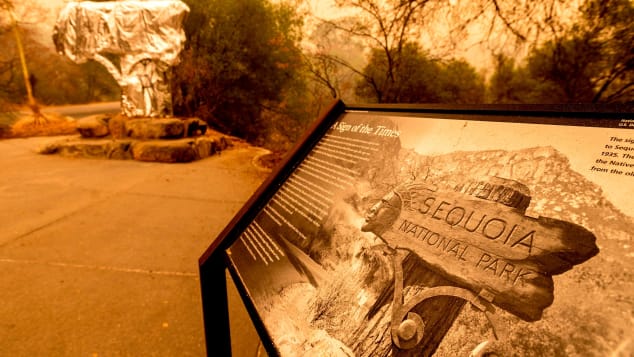Colliemom wrote:Sorry Anne, that was supposed to have read “Ida” and not “Idaho”. Dar spell correct changed my word and I didn’t catch it! I’m sure you have heard all about that storm and the mess it left behind.
Thanks, Sue. Yes, Ida was certainly a bad one. Like Martha, I truly feel sorry for all of the people in her area that are still without electricity, and so are also without a/c in the hot and steamy conditions there. Although fires here are bad (and are continuing, and will continue until we have a wetting rain) I think I would take fires and earthquakes over hurricanes and tornadoes. Truly, it is always something. . .
___________________
UPDATE 9-8-21 @ 8:25 a.m. (Wednesday)
__________________
All major fires previously listed continue to burn, although fire spread has moderated - somewhat - over the last several days, mostly due to calming winds (high wind being the primary driver of wildfire here).
Looks like that may change starting tomorrow (Thursday). A low pressure system is predicted to enter northern California with increasing winds; gusts up to 40 mph in areas of the Dixie Fire. Many areas of the Dixie fire are predicted to possibly receive a bit of rain (20% to 30% chance in many areas of these ongoing fires).
Whether or not rain actually falls remains to be seen.
Having lived in this area for more than 40 years, I know that a '30% chance of rain' is not a very good chance, more of the 'slim to none' variety, especially thinking of a "wetting rain". But one can hope! A "Wetting Rain" ("A widespread rain that over an extended period of time significantly reduces fire danger. One-tenth of an inch may be sufficient to reduce fire danger in grass fuel models. One half inch may be necessary for timber fuels under closed canopies." https://www.nwcg.gov/term/glossary/wetting-rain)
Unfortunately, along with this low pressure system will be the return of high winds, along with likely dry lightning strikes throughout the northern part of the state.
In 2020 (only last year!) the largest fire in California state history - the August Complex Fire, burning over a million acres - was ignited by lightning a little more than a year ago (August 16 - 17, 2020).
If anything, with "extreme drought" over much of northern California, conditions conducive to fire starts are worse now than they were last year.
Looking at the maps, it appears that Lassen Volcanic National Park has been about 75% burned over by the Dixie Fire (with fire still currently burning inside and outside the boundaries of the park).
The Antelope fire has been burning on the slopes of the Medicine Lake Volcano (by many estimates the largest volcano in the Cascade Range, with a "footprint" covering about eight-hundred square miles), and this morning Antelope appears to be on point of entering Lava Beds National Monument (home of about 600+ lava tube caves - one of the greatest concentration of such caves in the world). About 70% of the monument was burned over in August of 2020 by the Caldwell Fire, it looks like Antelope might now be trying to finish the job.
Further, it appears that the Monument Fire and the Haypress Fire may be on point of burning together to create still another mega fire in California’s mountainous coast range. Only about 5 miles separates the two fires from each other at the present time.
Additionally, many communities – both large and small – remain threatened by these fires.
FIRE UPDATES ARE BELOW THE PHOTOS
Photos are of the Dixie Fire - courtesy InciWeb



Dixie Fire - now at 922,192 acres (an increase of 8,340 acres over my previous update), 59% contained. Estimate of full containment October 30.
For further information on the Dixie:
https://inciweb.nwcg.gov/incident/7690/
Caldor Fire - now at 217,569 acres (an increase of 2,169 acres over my last update) 50% contained. Full containment predicted for September 27 (extended from September 7 on my previous update).
For further information on the Caldor Fire:
https://inciweb.nwcg.gov/incident/7801/
Monument Fire 189,366 acres (an increase of 29,218 acres over my last update) 41% contained. Estimate of full containment is still November 1.
For further information on the Monument Fire:
https://inciweb.nwcg.gov/incident/7750/
Antelope Fire – 73,558 acres, (an increase of 2,053 acres over my last update) 83% contained. Estimate of full containment September 30.
For more information on the Antelope Fire:
https://inciweb.nwcg.gov/incident/7764/
River Complex Fire – 135,689 acres (an increase of 14,416 acres over previous update) 19% contained (containment has been reduced from previous update due to fire spread). Estimate of full containment: October 1.
For further information on the River Complex Fire:
https://inciweb.nwcg.gov/incident/7760/
McCash Fire – 59,489 acres (an increase of 4,664 acres since my last update). 15% contained. Estimate of full containment October 31.
For further information on the McCash Fire:
https://inciweb.nwcg.gov/incident/7757/
McFarland Fire – 122,653 acres (fire size remains unchanged - acreage has not been updated since September 2) 98% contained. Estimate of full containment September 9.
For further information on the McFarland Fire:
https://inciweb.nwcg.gov/incident/7746/
Thanks to all for following this thread.
I remain very concerned at the possibility of lightning strikes igniting new fires tomorrow (Thursday) into Friday, and the possibility/likelihood of wind gusts, (both lightning and wind gusts initiated by the approaching low pressure area), causing further fire spread of the many fires still currently burning within the state.
Karen, I read yesterday of a new fire start in the Rogue River area of Oregon, have not seen any further details on this fire; so hoping it isn’t another bad one. If you have any details to share from your perspective, I am sure everyone would be happy to hear them. My sincere condolences on the loss of your home one year ago.
I will update this thread more often as new information becomes available.
Thank you.
Anne







